Just what the heck is a CJ750, anyway?
It’s a directly related “cousin” to our own Ruskie bikes so it must get a mention here.

The CJ story began in prewar Germany where BMW was building the last of its sidevalve bikes, the R71. Prior to the German invasion, the Soviets were already building copies of the R71, initially called the M-71 and later the M-72. Following the invasion, production was shifted from Moscow to Irbit (IMZ) in the Ural mountains where thousands were produced during the war and millions more to the present day. A second plant opened in Kiev (KMZ) also producing M-72’s.
With technical support from the USSR, CJ750 production commenced in Nanchang in the late 1950’s. (Various sources cite dates ranging from 1957 to 1961).
Today’s CJ750 M1 is a copy of the original M-72 right down to the 6V electrical system and other quaint features. The M1M is a slightly modernized version with a proper distributor, 12V electrical system and electric starter while the M1S is an OHV machine. The latter two models are equipped with reverse gearboxes. The CJ is NOT a replica of the R71. It’s a copy of the Soviet-built M-72 which was a knock-off of the R71. The word replica isn’t applicable.
What’s what?
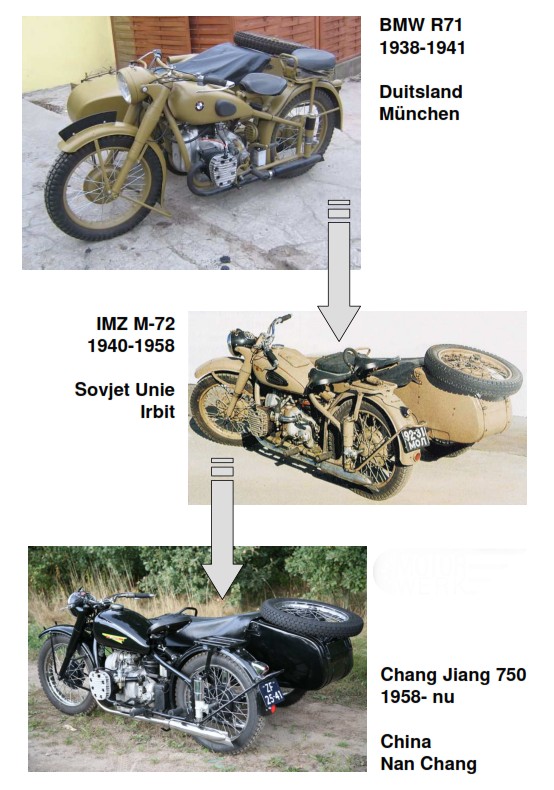
CJ Timeline
We often use different terms to refer to the same things which leads to some confusion, especially if you’re new to the CJ thing. Here are some basics:
SV – Sidevalve engine, aka a flathead or flattie. All M1s and M1Ms have sidevalve engines.
M1 – 6V, 22hp 746cc sidevalve. This is as true as you can get to the original R71 or M-72 predecessors.
M1M – 12V, 24hp 746cc sidevalve. Easily recognized by the external distributor on the forward, left side of the engine.
M1S – aka the Super, 12V, 32hp 746cc overhead valve engine.
OHV – Overhead valve engine. All M1S (Supers) have 12V, 32hp 746cc OHV engines.
R71 – BMW sidevalve bike from the late thirties that was copied by the Soviets throughout and after WWII.
M-72 – (Originally the M-71) The Soviet designation for their R71 copy. The CJ M1 is based on this machine.
650cc and 950cc OHV CJ engines were also made but they are very rare. Equally rare is the 6V OHV engine.
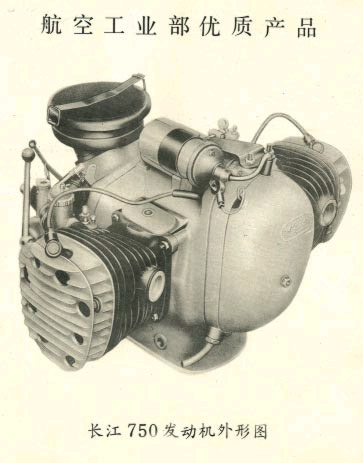
M1 sidevalve engine 6 volt electrics, sometimes referred to as X-Series
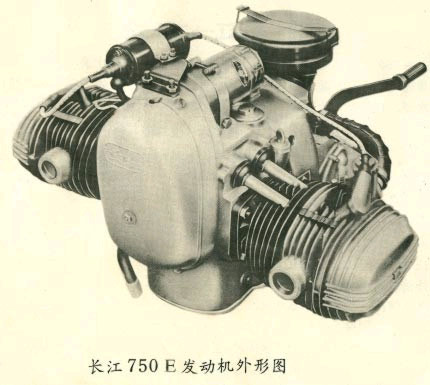
Overhead valve 6 volt engine
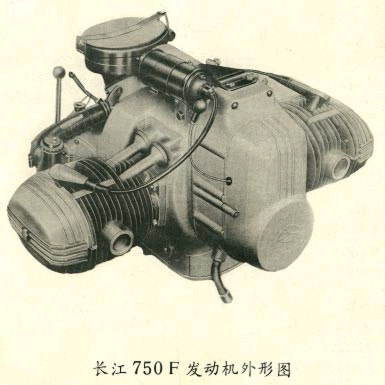
there were several other variants, including with electric starter
History
Chang Jiang (simplified Chinese: 长江; traditional Chinese: 長江; is the transcribed brand name of motorcycles that were once manufactured by the China Nanchang Aircraft Manufacturing Company. It takes its name from the Chang Jiang River, also known as the Yangtze or, in English, the Long River.
The CJ750 motorcycle is based on the 1956 Soviet IMZ (Irbitski Mototsikletniy Zavod) M-72 which was derived from the 1938 BMW R71. Nearly all of them have sidecars. They are often erroneously referred to as BMW “replicas” when in fact, they are derivatives of the IMZ M-72.
The CJ750 originated with the 1938 BMW R71, then, by way of the Soviet M-72, found its way to China as the Chang Jiang.

Early production
In 1950, the Peoples Liberation Army Beijing No. 6 Automotive Works developed a military motorcycle by reverse engineering a German Zundapp K500 motorcycle. The Zundapp-based machine entered production in 1951. 4,248 were built before military motorcycle production was transferred to the Hongdu and Xingjiang machinery plants. Both factories remain subsidiaries of the state-run aeronautics industry to this day.
By the mid-1950’s, the Soviets considered the M-72 to be obsolete. China would soon acquire all the tooling and produce their own M-72s. In light of this, the Zundapp-based machine was abandoned.
The Chinese M-72 was named the Chang Jiang 750. According to some sources, it entered production in November, 1957 at the state-owned Ganjiang machinery factory. Early production used Russian M-72 parts. Early CJs were nearly identical to M-72s.
The Chang Jiang drivetrain has been revised several times since production began. From 1957-66, CJs were equipped with so-called Type I engines and transmissions. This drivetrain was almost identical to those of the R71 and M-72.
In September, 1966, production of the Type II engine and gearbox began. It was not until 1972 that the Type II engine replaced the Type I in general use. Continued use of the Type I engine in 1966-72 was the result of a surplus of Type I components. With so many Type I engines in use, parts remained in production until the early 1970’s. When the military serviced Type I bikes, they would replace the engines and/or gearboxes with Type II components. This was done for ease of maintenance, parts availability, and improved engine characteristics. Bikes with Type I engines often had their original gearboxes replaced with a Type II. Engines manufactured with a serial number of 661802 and higher are Type II.
In the 1960’s, the factory was renamed the State-Owned Changjiang Machinery Factory.
In 1969, the CJ750 underwent some minor design changes, primarily related to sidecar frames and headlight-mounted switches. Gas tanks with built-in tool boxes appeared around this time.
In the late-1970’s, the factory was merged with airplane manufacturer Guo Ying Hongdu Ji Xie Chang. At this time, a 6V OHV engine with 30 horsepower was being developed. Only a few of these engines can be found today. They were quickly replaced with a 12V, 32 horsepower version.
In December, 1980, a small number of 900cc, OHV engines were produced in response to the acquisition of BMW motorcycles by the armed police. Only a handful of these machines were built, probably less than ten. Only a few 900cc engines have been found.
The most common models are:
The M1 which has a sidevalve (flathead) engine and a 6V electrical system. This model is a clone of the M72 and closely resembles the 1938 BMW R71.
The M1M is also a sidevalve, however it uses a 12V electrical system and is equipped with a reverse gear. It also has an electric starter where the M1 has only a kick-starter. All of these enhancements were designed by the Chinese.
The M1S (or “Super”) uses an overhead-valve engine, 12V electrical system, electric starter and reverse gear. The OHV system is of Chinese design.
All three models use the same frame and sheet metal. The M1 and M1M are nearly identical in appearance, but they can be distinguished by observing certain details.
CJ technological history includes racing bikes, experimental engines and futile attempts at modernizing the appearance of a long obsolete machine. Beginning in the mid-1980’s, over a decade after the normalization of relations between China and the USA, China opened its markets to foreign motorcycle manufacturers which expedited the end of CJ750 mass production. Today, the marque is kept alive by interest from hobbyists.
Modern production
The 750 OHV upgrade appeared in the mid-1980’s and entered production at the Ministry of Aviation and Space Engine Factory in Nanfang, Hunan Province. This marked the introduction of the M1S model.
In 1986, the M1 model was upgraded with a 12V electrical system and a gearbox with reverse, and designated the M1M.
Although the CJ750 is no longer produced per se, many have been restored from old military stock or assembled from parts. The CJ750 has become popular with enthusiasts outside China.
a further account
CJ750 sidecar (1) – Classic Harley & Indian Motorcycle Magazine …
By sidecarcj750
“Yangtze River 750″ was “cloned” from the Soviet M-72, and the latter arose from German BMWR71. R71 was successfully used in WW II by the Soviet Union. In the 1950’s, two M-72 vehicles were sold to China, and the Chinese started to produce their own M-72 (named as Yangtze River 750) in 1957. From the very beginning, the state-owned Chang-jiang Machinery Factory assumed the production of Yangtze River 750 products, and lots of M-72’s parts were installed in the product, such as mudguard, frame, wheel, starting key, and switch, etc.
Some complete vehicles produced by the Soviet Union were called Yangtze River 750, and some engines were refitted in Chinese style. However, people were able to differentiate China-made vehicles from Soviet Union-made vehicles, because Soviet Union-made vehicles’ engine case was smoother than that made in China.
In addition, the main frame and edge frame were slightly different from one another, and the difference in front mudguard is: the Soviet mudguard bracket was fixed by rivet, while the China-made mudguard was fixed by screw wire and cap.
In the 1960’s, the factory was renamed as the State-owned Yangtze River Machinery Factory, which was dedicated to airplane production till the end of 1970’s. Thereafter, the factory was renamed as State-owned Hongdu Machinery Factory, known as Nanchang Airplane Manufacturing Company in the 1990’s and Jiangxi Hongdu Aviation Industry Group today. By the end of the 1970’s, all Yangtze River series employed 6 Volt engines to supply power, and these engines had two models, namely, Yangtze River 750 Model I and Yangtze River 750 Model II. The former was similar to BMW R71 and M-72, but they were easily differentiated by the low position of the oil filler hole of the engine. In September 1966, Chinese people produced the Model II engine, which can be easily distinguished by the oil filler hole (dipstck) relocated towards the top of the engine. As of September 1966, all engines with above engine number 661820 models adopted Model II engine, and the Model I engine was widely replaced by the Model II engine as of 1972. The Model I engine’s production was terminated in 1966, but lots of new vehicles were equipped with Model I engine until 1971 due to large inventories.
Spare parts of the Model I engine were still produced till the 1970’s, and it was equipped with the same gearbox as M-72 while the Model II engine’s gearbox was newly researched.
Thereafter, the Model II gearbox was installed in many vehicles that adopted the Model I engine due to maintenance, parts, and other technical factors.
In 1969, Yangtze River 750 had been improved in technology, and the technical improvement was mainly centralized in edge frame and switches.
At the end of the 1970’s, China started to research and produce the 30-HP OHV engine, which is not widely used today.
In 1980, China started to put the 12 Volt engine with OHV 30 HP into mass production.
In 1986, the engine with flat-head cylinder cover was changed into 12 Volt in power, and it was equipped with a gearbox with reverse gear as well.
In December 1980, China started to put the Yangtze River 900 engine into small-scale production, (the 900cc engine was specially designed to meet army and police’s demands for motorcycles). This kind of vehicle and engine were limited in number, and the total number stayed below 10 units. Today, there are only 3 such engines in the world.
Since then, China’s Yangtze River series of vehicles has given birth to diverse models.
In addition, a great many factories started to produce Yangtze River 750 using different brand names such as Xiangjiang, Shandong, Changhong, Champion, Fengtong, Xihu, and Hongyan, etc.
Apart from the Jiangxi Hongdu Aviation Industry Group (the time-honored manufacturer), Nanchang Yangtze River Industry Company is regarded as the main manufacturer, and it provided the Jiangxi Hongdu Aviation Industry Group with supporting parts at the beginning. At the end of 1970’s, it started to produce complete vehicles.
By the end of 1990’s, the Nanchang Yangtze River Industry Company was producing a series of high-quality products. Also, it produced complete vehicles using new parts in stock, and these vehicles were equipped with the head frame (popular in 1960’s) and the high-quality 6 Volt military engine (popular in 1970’s).
Today, products of Nanchang Yangtze River Industry Company still have many problems, such as insufficient parts, and defects in quality due to cheap spare parts.
Since China’s reform and opening up, lots of private factories and small-scale factories started to produce parts and components with sometimes very low quality and cheap prices, which exerted a huge influence on Yangtze River products’ quality.
This report’s ultimate goal is to share our interest in Yangtze River products with you.
We are making unceasing efforts to legitimize the Yangtze River product’s origin, thus we always stress that Yangtze River is always Yangtze River regardless of being marked with BMW at the tank” and “To drive a Yangtze River motorcycle is our unmitigated privilege and honour.”
BMW R71 Buyers Beware!
A trend has developed to put BMW decals on Chinese-made motorcycles, they look the part and are often seen being ridden by war re-enacters. The downside has been that many an unsuspecting buyer has paid a fortune for what they were told was a real German BMW R71, only to find out later it’s Chinese! Buyers beware, do your homework!
One guy even went to the extreme of putting a swastika on the speedo face and he swore black and blue it was a BMW R71.
The CJ’s have a huge following and there are many good internet sites and forums.
Additional photos:

Changs at the ready! Police compound in Beijing 1982. Photo©JD
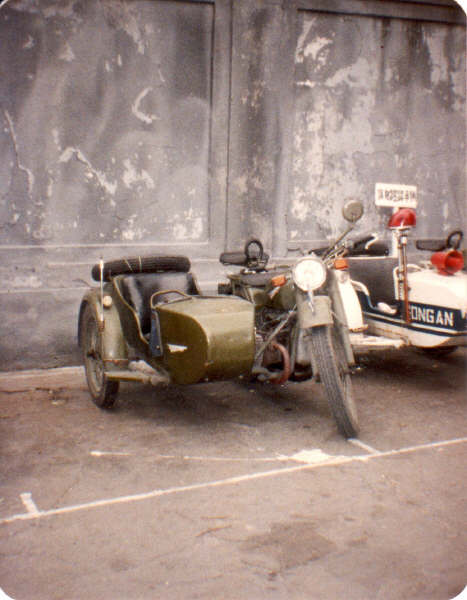
Police response vehicles. The word “GONGAN” means “SECURITY”, not the noise it makes if it hits someone. Photo©JD
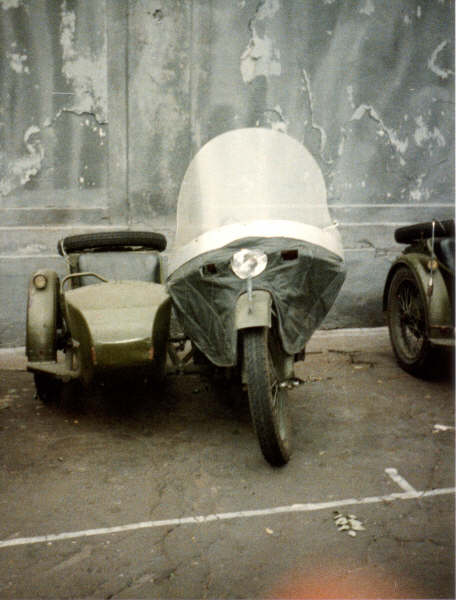
Nicely faired version. Photo©
Source: retrieved from b-Cozz archives
© b-cozz.com 2017
